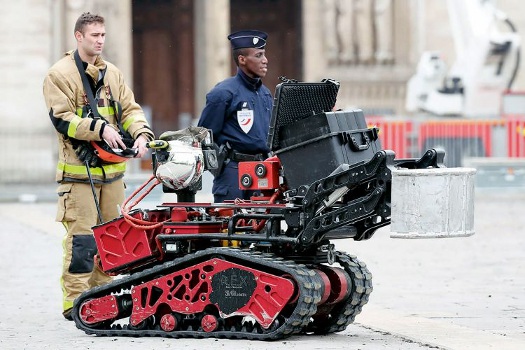 |
| February 11, 2020 | Volume 16 Issue 06 |
Designfax weekly eMagazine
Archives
Partners
Manufacturing Center
Product Spotlight
Modern Applications News
Metalworking Ideas For
Today's Job Shops
Tooling and Production
Strategies for large
metalworking plants
Machines spotlight:
The hero of Notre-Dame -- Firefighting robot

Made by Shark Robotics, Colossus is just over 5 ft long, 2.5 ft wide, and 2.5 ft tall. It weighs 1,100 lb empty.
In the spring of 2019, the famous French cathedral of Notre-Dame was heavily damaged in a devastating fire. But the Paris fire department prevented the complete destruction of the building with the help of a special robotic unit in their ranks.
It was April 15, 2019, 07:50 p.m.
In front of the eyes of an aghast public, the spire of Notre-Dame cathedral in Paris collapses. To firefighters, this isn't just a cultural tragedy: The collapse means the structure of the church is further destabilized by the flames. From this point on, entering the cathedral to fight the fire from within is very dangerous. The incident commander decides to send the robot Colossus into the cathedral.
Made of aeronautical-grade aluminum and welded steel, Colossus was built by the French company Shark Robotics. The company employs 20 people and builds high-tech robots to assist or even replace humans in especially dangerous environments. Their robots are capable of moving in rough terrain. Equipped with an articulated arm, they assist firefighters or help with defusing explosives or removing other dangerous objects.
VIDEO: Colossus firefighting robot in action at Notre Dame. [Credit: Le Parisien]
A modular system as a recipe for success
Colossus was developed in collaboration with the Paris fire department. It's not just suitable for fighting fires, but also for rescuing people (it can carry 1,100 lb) after the collapse of a building or for removing biohazards. Since the tasks vary so much, Shark Robotics decided to use a modular design. A base unit is equipped with quick-change tools (with changes often made in 30 seconds) suitable for the mission.
The just-over-5-ft-long Colossus can operate up to 12 hours autonomously using its six onboard lithium-ion batteries. It has two main 4,000-W electric motors for locomotion on its tracks, electromagnetic brakes, and a top speed of 2.2 mph. Collosus is operated by a wireless double-joystick portable controller with a display that can be used up to 1,000 ft away (long-distance operation is also an option with additional equipment).
In addition to sporting a high-pressure water cannon (can be motorized), Collosus can be equipped with a 360-degree pivoting HD camera. The robot can also be equipped with sensors that measure parameters like temperature or radiation exposure and detect the presence of toxic substances.
It is completely sealed against dust and water and resists powerful heat radiation.
VIDEO: Colossus firefighting robot shown in different scenarios. [Shark Robotics]
Colossus can carry a smoke extractor to make an affected area accessible to human firefighters. A gripper arm enables it to clear a path into the area first. The robot can also be equipped with a stretcher, a rescue cage, or a ram.
3,000 liters of water per minute
During the fire of Notre-Dame, the fire hose of the robot was used to keep the inner walls of the church and the structural elements of the building wet and prevent the fire from spreading. Via a supply hose, the robot was provided with almost 3,000 liters of water per minute -- without the slightest danger to human personnel.
Designing a robot like this is a technological challenge. For this reason, Shark Robotics contacted mdp - maxon France. For the gripper arms of the robot, the designers were in search of motors that were compact, powerful, and efficient.
"Our robots need highly resilient motors that are suitable for extreme operating conditions," says Jean-Jacques Topalian, managing director of Shark Robotics for R&D. "The decision to use maxon was an easy one for us: The company has an excellent track record, and its motors have already proven themselves in hostile environments."
Shark Robotics currently uses 19 different maxon products and obtains the motors directly from the drive specialist's website. The same electric motors are built into the European rover that will start roaming planet Mars in 2021 -- another incredibly hostile environment.?
Read more interesting maxon motor application stories at https://drive.tech/en/.
Original article courtesy of maxon. Some new details added.
Sources: maxon, Shark Robotics
Published February 2020
Rate this article
View our terms of use and privacy policy
